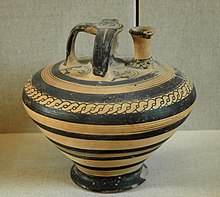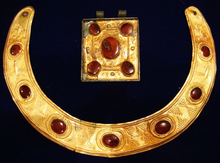
Back قطع أثرية (علم الآثار) Arabic Artefakt Azerbaijani Артэфакт (археалогія) Byelorussian Артефакт (археология) Bulgarian Artefacte arqueològic Catalan Artefakt (archeologie) Czech Artefakt (arkæologi) Danish Artefakt (Archäologie) German Τέχνεργο (αρχαιολογία) Greek Artefakto (arkeologio) Esperanto

An artifact[a] or artefact (British English) is a general term for an item made or given shape by humans, such as a tool or a work of art, especially an object of archaeological interest.[1] In archaeology, the word has become a term of particular nuance; it is defined as an object recovered by archaeological endeavor, including cultural artifacts (of cultural interest).
"Artifact" is the general term used in archaeology, while in museums the equivalent general term is normally "object", and in art history perhaps artwork or a more specific term such as "carving". The same item may be called all or any of these in different contexts, and more specific terms will be used when talking about individual objects, or groups of similar ones.
Artifacts exist in many different forms and can sometimes be confused with ecofacts and features; all three of these can sometimes be found together at archaeological sites. They can also exist in different types of context depending on the processes that have acted on them over time. A wide variety of analyses take place to analyze artifacts and provide information on them. However, the process of analyzing artifacts through scientific archaeology can be hindered by the looting and collecting of artifacts, which sparks ethical debate.

Cite error: There are <ref group=lower-alpha> tags or {{efn}} templates on this page, but the references will not show without a {{reflist|group=lower-alpha}} template or {{notelist}} template (see the help page).
- ^ "artefact. (n.d.)". Collins English Dictionary – Complete & Unabridged 11th Edition. Retrieved 2 August 2012 – via CollinsDictionary.com.